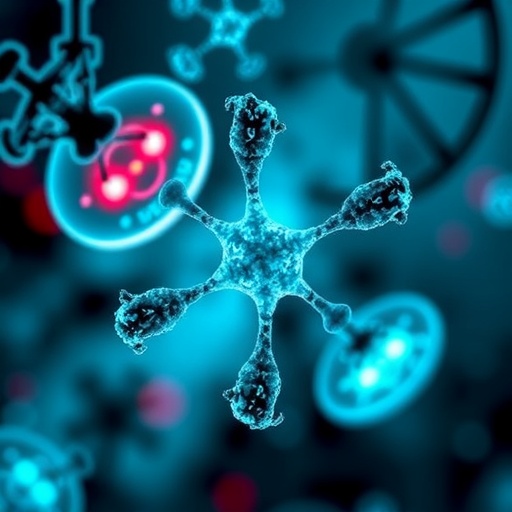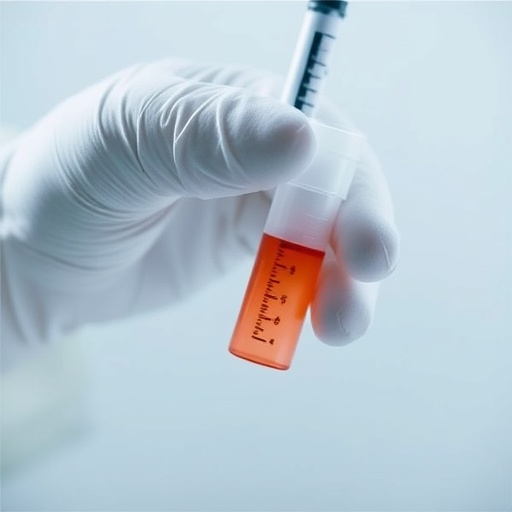
Research into the molecular underpinnings of cancer treatment has taken a significant leap forward, particularly in the realm of cervical cancer and its response to radiotherapy. A recent study conducted by Zan, Liu, Yin, and colleagues delves deep into the tumor immune microenvironment, proposing the identification of hub genes that may influence radiotherapy sensitivity in locally advanced cervical cancer. This groundbreaking research could pave the way for more personalized treatment strategies, aimed at enhancing therapeutic efficacy while minimizing adverse outcomes.
Cervical cancer is a major global health concern, particularly among women. Despite advances in treatment modalities, a substantial proportion of patients still exhibit resistance to radiotherapy. The study by Zan et al. proposes that the immune microenvironment surrounding tumors plays a critical role in mediating this resistance. Through a meticulous analysis of patient-derived data, the researchers aim to unveil the genetic and molecular interactions at play, establishing a framework for future therapeutic interventions.
The importance of the immune system in cancer treatment cannot be overstated. The immune microenvironment is composed of various immune cells, cytokines, and chemokines that can either support or hinder tumor growth. By focusing on the immune milieu, the authors highlight a novel dimension of cervical cancer treatment that not only seeks to attack cancer cells directly but also aims to modulate the immune response to improve patient outcomes. This dual approach may ultimately enhance the effectiveness of radiotherapy, leading to better survival rates.
To elucidate the mechanisms of radiotherapy sensitivity, the researchers executed a comprehensive bioinformatics analysis of gene expression profiles. The identification of hub genes—central genes within a network of biological interactions—was instrumental in uncovering pathways that might be contributing to differential responses among patients. This theoretical scaffold provides a deeper understanding of the complexity of cancer biology and opens the door to future investigations focused on therapeutic modulation.
The findings suggest that specific hub genes may serve as biomarkers for predicting radiotherapy sensitivity. These biomarkers could guide clinicians in stratifying patients based on their likelihood of benefiting from radiotherapy. The potential to personalize treatment regimens based on genetic markers not only holds promise for improved efficacy but also significantly reduces the incidence of treatment-related toxicity, enhancing the patient’s quality of life during and after treatment.
Moreover, the research establishes a connection between genomic alterations within tumors and the activation or suppression of certain immune pathways. This relationship is crucial for understanding the mechanisms that lead to resistance against standard treatments. By elucidating these molecular pathways, the authors provide vital insight into the development of combination therapies that integrate immunotherapy and radiotherapy—a burgeoning area of research in oncology.
In addition to establishing linkages between specific genes and treatment outcomes, the study articulates the importance of the tumor microenvironment. It becomes increasingly clear that the environment surrounding a tumor can drastically influence its behavior and treatment response. The research underscores the complexity of tumor biology, advocating for a more holistic approach to cancer care that considers not only the genetic profile of tumors but also their microenvironmental context.
Another significant aspect of the research is its implications for future clinical trials. As researchers and clinicians strive for more effective treatments, the integration of immune profiling and genetic testing may lead to groundbreaking advancements in patient care. By validating the discovered hub genes through further investigation and clinical applications, the scientific community could shift towards more targeted interventions that improve outcomes for cervical cancer patients.
Furthermore, the study opens up avenues for further investigations into therapeutic agents that could modulate these identified pathways. By developing drugs aimed at enhancing the immune response in conjunction with radiotherapy, oncologists might be able to convert some resistant tumors into responsive ones, significantly impacting patient survival. The potential for discovery in this area is vast and holds promise for additional breakthroughs in cancer therapy.
In the context of public health, the findings underscore the urgent need for improved diagnostic and treatment strategies for cervical cancer. As a preventable disease, effective screening and early intervention remain critical components of combating cervical cancer globally. However, for those who progress to advanced stages, research like that conducted by Zan et al. demonstrates the necessity of continued investment in understanding how we can make existing treatments more effective through an enhanced understanding of tumor biology.
As the field continues to evolve, researchers hope that the relationships uncovered in this study will be replicated across other cancer types, leading to a broader understanding of how the immune microenvironment shapes treatment responses. The implications of these relationships reach far beyond cervical cancer, potentially impacting the treatment of multiple malignancies in the future.
Ultimately, the work conducted by Zan and colleagues represents a vital step towards unraveling the complexities of cancer treatment. As personalized medicine becomes increasingly integrated into oncological practices, the insights gained from this research are sure to resonate in the years to come. By harnessing the power of molecular biology and immunology, healthcare professionals may be better equipped to tailor therapies that meet the unique needs of each patient, a goal that sits at the heart of contemporary oncology.
As the academic and clinical communities rally around this compelling research, it is crucial that we advocate for continued study and funding in this area. Altogether, the ultimate aim is to translate these scientific discoveries into real-world applications that can save lives. As we turn our attention to future therapies based on a deeper understanding of the interplay between the tumor immune microenvironment and radiotherapy, we move forward in the fight against cervical cancer with newfound hope and purpose.
Throughout the field of oncology, the significance of research like this is profound. By shedding light on the genetic underpinnings of treatment response, studies such as the one led by Zan et al. will inform not just clinical decisions but also the direction of future research initiatives. The opportunity to shift paradigms in cancer treatment is here, and it is incumbent upon scientists, clinicians, and policymakers alike to embrace this moment—coming together to ensure a brighter future for those affected by cancer.
Subject of Research: The relationship between tumor immune microenvironment and radiotherapy sensitivity in locally advanced cervical cancer.
Article Title: Identification of hub genes and potential molecular mechanisms of tumor immune microenvironment-related radiotherapy sensitivity in locally advanced cervical cancer.
Article References:
Zan, Y., Liu, Q., Yin, Y. et al. Identification of hub genes and potential molecular mechanisms of tumor immune microenvironment-related radiotherapy sensitivity in locally advanced cervical cancer. Reprod. Sci. 32, 2607–2632 (2025). https://doi.org/10.1007/s43032-025-01909-4
Image Credits: AI Generated
DOI: https://doi.org/10.1007/s43032-025-01909-4
Keywords: Hub genes, cervical cancer, radiotherapy sensitivity, tumor immune microenvironment, molecular mechanisms.
Tags: cervical cancer radiotherapy sensitivityenhancing therapeutic efficacygenetic interactions in cancerhub genes in cancer treatmentimmune cells in tumor microenvironmentimmune system role in cancer therapymolecular underpinnings of cervical cancerpatient-derived data analysispersonalized treatment strategiesresistance to radiotherapy in cervical cancertherapeutic interventions for cervical cancertumor immune microenvironment




